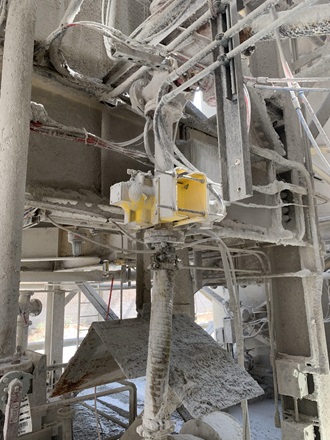Measuring density with a non-contact measurement: Application of the month |
Asphalt shingles are made of fiberglass, asphalt, and ceramic-coated minerals. Fiberglass mats are run through a machine, coating the mats in asphalt multiple times. Near the end of the process, the ceramic-coated minerals are added for protection and color.
To glue the final layer of mineral topcoat onto the fiberglass mats, manufacturers use a mixture of asphalt and lime. The ratio of these two ingredients changes the asphalt mixture’s adhesive properties and its density, so a density measurement is critical for monitoring the adhesive properties of the mixture as it’s applied.
A density measurement without the hot, sticky mess
Most density sensors make measurements by touching the fluid or liquid being measured. However, a hot, sticky mixture of asphalt and lime poses a number of potential challenges ranging from instrument failure from extreme heat to measurement errors resulting from buildup on the sensor.
A roofing shingle manufacturer in California opted to avoid these headaches and use radiometric technology for a density measurement in a pipe transferring their asphalt-lime mixture. The MiniTrac 31 radiometric density sensor mounts on the outside of the pipe opposite of a radiometric source. Radioactivity from the source travels through the pipe and the materials within, and the detector on the other side measures the activity to infer a density measurement.
A valuable measurement is made without interfering with the process or coming into contact with the sticky mixture it’s measuring. Operators can control the adhesive properties of the mixture in real-time with full confidence in the accuracy and the reliability of their measurement.
Density measurements in universal applications
The MiniTrac 31 is as reliable as it is resilient, and for this reason, it’s used in applications across industries. Radiometric density sensors are most commonly found in refineries, paper mills, and mines, all of which are notoriously tough on their instrumentation because the processes found there use extreme pressures or temperatures that cause other sensors to fail. Despite the harsh conditions, the MiniTrac 31 can last for 20 years or more because of its robust design and external mounting.
Every pipe and vessel has unique properties, so VEGA carefully examines each application individually to recommend the best instrument configuration and installation to provide the best solution possible. For a non-contact density measurement, it’s best to consult your VEGA seller or representative to determine what would work best.
Related products
Export this article
Download as PDFShare this article
Comments ({{comments.length}})
{{getCommentAuthor(comment, "Anonymous")}} {{comment.timestamp | date : "dd.MM.yyyy HH:mm" }}
{{comment.comment}}


